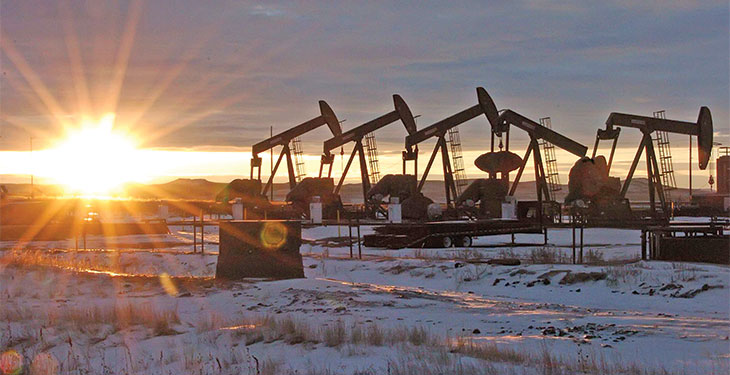The competition between the USA and Middle Eastern countries has always been strong. However, when the USA started using more efficient and cost effective drilling techniques (e.g. hydraulic fracturing) the Organization of the Petroleum Exporting Countries (OPEC) came under increased pressure to stay competitive and maintain its revenue. The response came in the form of lifting national production quotas that would otherwise keep the supply-demand balance in check. The result was that the market was free and unconstrained to set the price of the oil barrel – the oversupply led to a massive decline in the cost of oil which was not stopped by the traditional shake-out in the market. As neither party seems to be willing to cap its production, it is unlikely that the price of the oil barrel will recover anytime soon.
 A first explanation for this prediction may be the socio-political background of the OPEC countries. Out of the twelve members, neither country comes close to being the democratic establishment that is the USA – rather, many lack a stable political setting, with a specific group (Algeria, Iraq, Libya, Nigeria, Venezuela) being labelled as the ‘Fragile Five’. Although this predicament is not necessarily mutually exclusive with long-term, sound economic development, it creates the enhanced risk that political implications will weigh heavier in the countries’ agendas. Saudi’s Arabia desire to quickly develop its economy by producing crude oil at full troth has proven a strategic mistake resulting in the highest budget deficit in the last thirty year. Furthermore, Iran is particularly eager to increase its oil production after the USA lifted their embargo on the Middle Eastern country. In the current context, because of possible adverse political implications and the high costs of shutting down oil probes, it is unlikely that OPEC countries will cut the supply of oil. Equally, the USA does not seem ready to decrease production and neither does it have a reason – the cost of exploring and drilling oil is decreasing at the same rate as the price of oil.
A first explanation for this prediction may be the socio-political background of the OPEC countries. Out of the twelve members, neither country comes close to being the democratic establishment that is the USA – rather, many lack a stable political setting, with a specific group (Algeria, Iraq, Libya, Nigeria, Venezuela) being labelled as the ‘Fragile Five’. Although this predicament is not necessarily mutually exclusive with long-term, sound economic development, it creates the enhanced risk that political implications will weigh heavier in the countries’ agendas. Saudi’s Arabia desire to quickly develop its economy by producing crude oil at full troth has proven a strategic mistake resulting in the highest budget deficit in the last thirty year. Furthermore, Iran is particularly eager to increase its oil production after the USA lifted their embargo on the Middle Eastern country. In the current context, because of possible adverse political implications and the high costs of shutting down oil probes, it is unlikely that OPEC countries will cut the supply of oil. Equally, the USA does not seem ready to decrease production and neither does it have a reason – the cost of exploring and drilling oil is decreasing at the same rate as the price of oil.
Other indicators for the fact that the price of crude oil will not increase significantly are the oil related derivatives. One example could be the price of oil for future delivery – the value of a barrel of crude oil to be delivered in 2020 is only $20. This is surprising as oil prices for future delivery are usually much more stable than volatile near-terms prices and usually hold their value even when the spot market crashes. The most sensible explanation for the low value of this derivative is that it is a reflection of the market’s apprehension and general fragility. It serves as a good indicator of sentiment because the crude oil market is one where speculators bet on forward prices, and also allow large producers and consumers to hedge future business. In this context, if investors are reluctant to invest in cheaper, future oil, it is rather unlikely that current demand for oil will increase, implicitly driving the price up. The market’s disinterest and oversaturation can also be seen in the aggressive oil put options – contracts giving the right to sell oil at a particular level in the future – appearing as low as $35 and even $30 a barrel for US crude oil.
The indicators are grim, and arguably even grimmer in the context of a very fragile economy and precautious lending system. The drop in the price of crude oil has come at the worst possible moment, when the economy has barely recovered from the economic crisis and when national, supranational and international institutions are imposing harsher regulations on monetary institutions of all sort. These new regulatory schemes generally dictate less ability for the banks to be flexible or forgiving towards their clients, including crude oil investors. There are two causal links between investors and banks: either the investors have already borrowed money and are under a duty to pay it back or they need funds in order to modernise/expand their facilities in an effort to maximise production and stay competitive. In the first case, the reality is that banks are less forgiving and debtors under increased pressure to pay the debt – this, in turn, means they are more likely to maintain the high supply and implicitly low price, in an effort to increase revenue and meet their outstanding debts. Secondly, investors are less likely to secure new loans – in an industry where companies need capital expenditure in order to make money this can be highly detrimental. It again translates in increased pressure for the investors to maintain the high production, given that they can’t increase revenue through new investments.
The declining price of crude oil also impacted the market in Romania, in terms of investments and fuel prices. For consumers, gasoline did not suffer the desired price decrease – even though the value of oil shrunk by almost half, the fuel price dropped by only 8,5%. This is due to the fact that half of the price of gasoline is represented by state excises, which actually increased in the last months. However, there are some good prospects that the intended elimination of the extra duty on fuel in the near future would help into transmitting this oil price decline into the economy.
However, the Romanian Leu-US Dollar conversion rate and the oil companies’ policies also prevented the gasoline price from diminishing. For Romanian companies, the low prices of oil proved detrimental – in 2015 Petrom investments have decreased by 29%, from 2,9 billion lei in the first semester of 2014 to 2,06 billion lei for a similar period in 2015. Connected products have also suffered from the depreciation of the oil price – Romgaz, a state owned company, has announced that profits have fallen by 12% compared to the same period of last year. This fall in demand is rather more surprising in the context of an economic growth of 4,3% in the first trimester of this year. However, there were several external and unrelated factors that also contributed to the decline in interest for natural gas: late regulations for the 2015-2016 winter, uncertainty regarding price liberalization in the regulated market sector and the insolvency of important clients. The low oil price has not been the only culprit for this situation.
————————————-
The full version of this article can be read in printed edition of energynomics.ro Magazine, issued on September 2015.
In order to receive the next issue (December 2015) of energynomics.ro Magazine for free, we encourage you to write us at office@energynomics.ro to include you in our distribution list.
